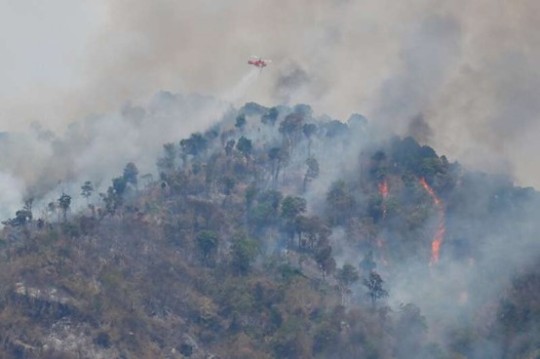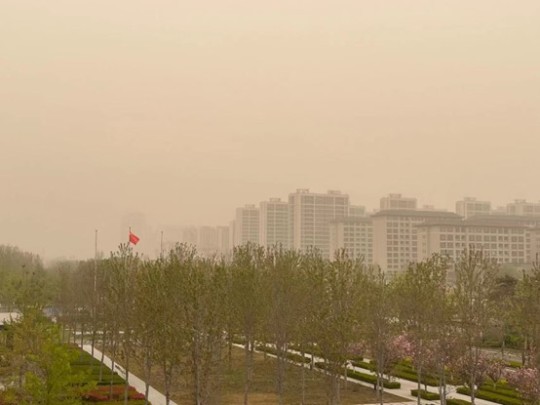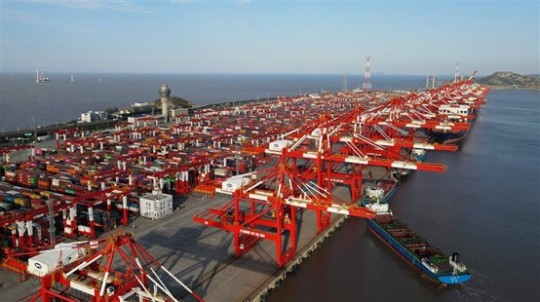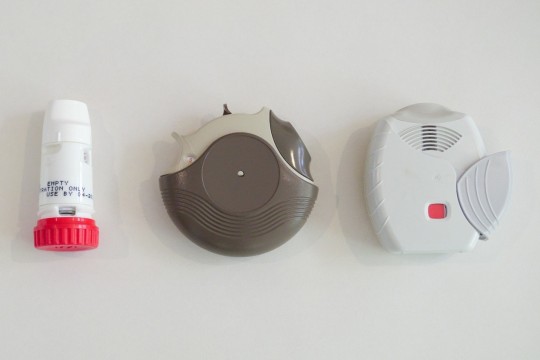Hi, I am Haoyang Tang, Aaron. I am a MS student from Chemical Engineering at Columbia University. I like nature, travel, games. Glad to be your friend!
Don't wanna be here? Send us removal request.
Text
Thailand air pollution caused by forest fires and stubble burning deters tourists and leads millions to seek medical help
The past month has been an extremely difficult time for people in northern Thailand, particularly for people in Chiang Mai. Forest fires ravaged northern Thailand in late March. The smoke released from the forest fire quickly covered Chiang Mai. Chiang Mai was ranked the world's most polluted city. Thai government have stated on 28 March that about 1.7 million people across the country was currently affected by hazardous air. By April 20th, 2.4 million people have sought medical treatment for respiratory problems since the start of the year. In Chiang Mai, more than 12,000 patients sought medical treatment for respiratory issues between January and March.

Figure 1. Chiang Mai as pictured on 12 March 2023.
In addition to concerning health crisis, tourism in northern Thailand has also been severely impacted. One owner of a tourism firm cried that she only got one customer last week and no customer this week. Narumon Pinyosinwat, Thai government spokeswoman, explained that stubble burning, along with other factors, including recent drought and prevailing wind patterns, were the possible causes of the fires.
Stubble burning is an act of cutting down natural vegetation and burning them to clear land for cultivation. The processes are repeat by the farmers when the plot of land becomes infertile. This type of agribusiness has long been proven inefficient and unsustainable. Stubble burning not only leads to air pollution, but also loss of habitat for wildlife species. In many countries, including China, the UK, and Australia, stubble burning has been prohibited.

Figure 2. A firefighting helicopter extinguishing a forest fire in Chiang Mai, Thailand on March 29, 2023.
There are many alternatives to stubble burning. Stubble can be processed and mixed with cow dung and some natural enzymes to fertilize the soil. Stubble has another application, which is more simple. I had a trip to a farmland in Suzhou during my undergraduate and saw that straws were stuck deep in the soil. The professor told us that decomposition of straws in natural processes was slow, and these straws scattered here and there were not used as fertilizer. “Instead, straws could moisturize the soil by bringing rainwater deep into the soil,” the professor continued. Stubble, along with other plant residues, can also be used for producing biofuel. In fact, the Union government is working on a plan to use stubble as a biofuel as a part of an effort to deal with stubble burning.
Last but not least, I hope the people in northern Thailand could get through this tough period. And I hope Thai government could learn from the lessons and provide farmers with other alternatives considering their financial situation.
News Source:
1 note
·
View note
Text
Air Pollution and Policy in Shanghai
On April 11th, my mother sent me a photo of the sandstorm hit in Yanzhou, Shandong, China, as she was on her business trip. The photo reminded me of the days 10 years ago in Shanghai, my hometown. Back in 2013, the light rail station three kilometers away from my home was often covered in haze on regular days. Stringent multiregional air pollution control strategies have been implemented in the recent decade in Shanghai. According to the data from Statista, the annual average PM2.5 air pollution levels in Shanghai have decreased from 59.86 ug/m3 air in 2013 to 26.52 ug/m3 air in 2022. Despite huge improvement, air pollution still remains a huge problem in Shanghai, as annual average PM2.5 pollution levels of 26.52 μg/m3 air is still much higher than the standard of 5 μg/m3 established by WHO. Nonetheless, the policy implemented so far in Shanghai has been proved effective.

Figure 1. The sandstorm in Yanzhou, Shandong, China (filmed by my mother)
Shanghai is a typical representative of developed coastal cities that heavily relies on import and export trade. Ship emissions could contribute 10 to 30% of PM2.5 within 10 km of the coastal and riverine port area. The seaside wind in summer monsoon season carries the pollution further into the central area in Shanghai. To address the issue, Shanghai has adopted the Emission Control Area (ECA) policy to reduce ambient SO2 and particle components. Strict ship diesel emissions standards are included in the ECAs. Ships in ECAs are required to replace high sulfur oil with light oil that contains sulfur content less than or equal to 0.5%. The ECAs have been proven effective. The SO2 concentration in Shanghai decreased by at least 0.229 μg/m3 daily on average due to the ECA policy implementation. From 2015 to 2017, the average 3-month SO2 concentrations decreased by 27% to 55% in both port sites and urban sites in Shanghai, with the highest decrease of 55% in Gaoqiao site (port site), which is influenced by heavy ship traffic activity.

Figure 2. Yangshan port, Shanghai (Image Link: https://www.shine.cn/biz/economy/2111218489/)
However, there are downsides of ECAs. First, although SO2 and PM2.5 emissions decreased effectively in ECAs, NOx emissions that primarily depends on engine temperature and combustion cycle did not. In addition, OC components in ship-emitted particles increased as some organics like toluene from low sulfur heavy fuel oil were much higher than those from high sulfur heavy fuel oil.
The ECAs are still being implemented today, with time, ships will use light oil that has sulfur content below 0.1%. Meanwhile, Shanghai has implemented policy in other aspects and keeps introducing new policy for air pollution control. For example, Shanghai has been expanding clean energy vehicles and all-electric bus. Nowadays, there are much more vehicles with green license plates (electric or hybrid power) than vehicles with blue license plates (traditional fuel). Temporary shut down and penalties for polluting factories have also contributed to air pollution control. Someday, we might breathe the fresh air that meet the WHO standards in large cities like Shanghai.
References:
Liu, Q., Liu, X., Liu, T., Kang, Y., Chen, Y., Li, J., & Zhang, H. (2020). Seasonal variation in particle contribution and aerosol types in shanghai based on satellite data from modis and caliop. Particuology, 51, 18-25.
Wu, R., Dai, H., Geng, Y., Xie, Y., Masui, T., Liu, Z., & Qian, Y. (2017). Economic impacts from PM2. 5 pollution-related health effects: a case study in Shanghai. Environmental science & technology, 51(9), 5035-5042.
Zhang, Q., Zheng, Z., Wan, Z., & Zheng, S. (2020). Does emission control area policy reduce sulfur dioxides concentration in Shanghai?. Transportation Research Part D: Transport and Environment, 81, 102289.
Zhang, X., Zhang, Y., Liu, Y., Zhao, J., Zhou, Y., Wang, X., ... & Chen, J. (2019). Changes in the SO2 level and PM2. 5 components in Shanghai driven by implementing the ship emission control policy. Environmental science & technology, 53(19), 11580-11587.
1 note
·
View note
Text
Aerosol Therapy
Four years ago, in autumn of 2019, I developed symptoms of breathing difficulties during vigorous exercise and diagnosed chronic bronchitis half a year later. Bronchitis is an inflammation of the airways in the lungs. Sadly, there is no cure for chronic bronchitis, and I can still feel the presence of if every day. I used to use inhalants to relieve the symptoms and I have been curious about the aerosol therapy. One important question is, what are the determinants of the effectiveness of aerosol therapy?
The efficacy of aerosol therapy depends on four major factors, aerosol output, drug-related factors (particle size and molecular weight), deposition, and delivery. The above four factors interact and influence each other.
Aerosol output refers to the total mass of the particles that are produced by aerosol generator for dispersion. Dosing of drugs, molecular weight of particles, and types of aerosol devices all controls the aerosol output. It would be implausible to elaborate on how each factor influence the aerosol output since aerosol output requirements are considerably different from one respiratory disease to another. One thing to be consider when formulating the dosing of the aerosol drug is the drug losses. The actual amount of drug delivered into the trachea might be less than 60% and less will reach the alveolar space.
Most therapeutic aerosol particles have the particle size between 2 to 5 um. Following inhalation in the airways, macromolecules that have molecular weight less than 40 kDa could be better absorbed in the bloodstream while those are heavier than 40 kDa are absorbed more slowly. Typically, molecules with molecular weight larger than 30 kDa need to be assisted with absorption enhancer for better absorption in the alveoli.
Deposition of aerosol particles in the airways occurred by impaction, sedimentation, and diffusion (figure 1). Inertial impaction predominates in the first 10 branching of the airways. Sedimentation predominates in the distal five to six airway generations due to low air velocity. Both sedimentation and diffusion influence drug deposition at the alveolar level. When using metered dose inhaler (MDI), which is one common type of aerosol devices, I was told to hold the breath for around 15 seconds after inhalation. The breath holding process is actually allowing drug particles to deposit in the airway with minimal air velocity.

Delivery of aerosol drugs to the inflamed airways are influenced by aerosol doses, formulation of drug (drug-related factors), patient factors, and device factors. To reiterate, aerosol output, drug property, deposition, and delivery interact and influence each other. There are three types of aerosol drug delivery devices, metered dose inhaler (MDI), dry powder inhaler (DPI), and nebulizer. Each type of device has its advantages and disadvantages. MDIs (figure 2) offer reduced cost and convenient medicine delivery and require slow inhalation process. DPIs (figure 3) require less timing and coordination than MDIs and require a fast inhalation. Nebulizer (figure 4) produces aerosol continuously and are preferred by the patients who are unable to use an inhaler. From personal experience, I used both MDIs and DPIs (the first one in figure 3 from left to right). MDIs are often used to ease the symptoms. DPIs may contain combination of drugs that ease the symptoms and cure the disease. Sadly, I quit using both MDIs and DPIs since they have little effects in improving my conditions. My case again confirms the difficulties in curing chronic bronchitis.

Figure 2. Metered Dose Inhaler (MDI)

Figure 3. Dry Powder Inhalers (DPIs)

Figure 4. Nebulizer
Respiratory diseases have different causes. More often in chronic cases, the causes cannot be explained. I hope this blog widens your knowledge about aerosol therapy as one of the major methods to treat respiratory diseases. Last but not least, maintaining healthy habits (ex. no smoking) and breathing fresh air definitely will reduce the probability of getting respiratory diseases. If you are unlucky like me, who never smoke but still got chronic bronchitis, try aerosol therapy, and see if it works on you.
References:
Dhanani, J., Fraser, J. F., Chan, H. K., Rello, J., Cohen, J., & Roberts, J. A. (2016). Fundamentals of aerosol therapy in critical care. Critical Care, 20(1), 1-16.
Respiratory Therapy Zone (2021). Aerosol Output (Medical Definition) | Respiratory Pharmacology. https://www.youtube.com/watch?v=banFzjn7m_4
Respiratory Therapy Zone (2022). Aerosol Drug Therapy for Lung Diseases [OVERVIEW]. https://www.youtube.com/watch?v=vEjvziMuW4o
Sims, M. W. (2011). Aerosol therapy for obstructive lung diseases: device selection and practice management issues. Chest, 140(3), 781-788.
1 note
·
View note
Text
Stratospheric sulfur injection
Global warming is absolutely one of the greatest global challenges in 21st century. A combination of policy decisions and technology innovation has been implemented to cope with global warming. Stratospheric aerosol injection (SAI) was first proposed by a Russian climatologist in 1974. SAI is a proposed geoengineering technique to mitigate the effects of climate change by injecting sulfur dioxide into the stratosphere. The injected sulfur dioxide would form scattering sulfate aerosols and reflect the sun’s incoming radiation back into space, thereby cooling the planet. The 1991 eruption of Mount Pinatubo in the Philippines reinforced the idea since the aerosol layer formed by particulate matter and sulfur dioxide released from the volcano lowered the average global temperature by about 0.5 °C over the following few years. However, after years of heated debate, the idea is still highly controversial and is far from implementation. Multiple models have been proposed to explore the feasibility of SAI and the dangers associated with the idea.

Figure 1. Different geoengineering techniques proposed for mitigation of the effects of climate change (SAI is 3)
However, potential side effects of sulfur injections raise concerns about the feasibility of the project. One of the biggest concerns is the destruction of ozone layer, particularly in southern hemisphere (SH) polar vortex, as a result of SAI. Study have predicted a decrease of total column ozone (TCO) between 8% to 20% within 10 years after the start of the injection experiments. TCO in SH polar vortex recovers in 80 years. TCO in northern hemisphere (NH) polar vortex is predicted to be less impacted, which would only decrease by less than 5% within 10 years and increase by 20% in 70 years. Despite recovery of ozone layer by the end of the century, the abrupt decrease in column ozone in the first 10 years after the start of the injection could bring catastrophic consequences. In addition to ozone layer destruction, other concerns include public health impacts of SAI aerosols, heavier rainfalls that might lead to flooding, acid rains, droughts, etc., that could harm public health, ecosystem and agriculture.
To sum up, SAI is an economic and feasible method to mitigate climate change. However, potential side effects of SAI and tremendous uncertainties in modeling hinder the project from initiation, at least for now. The primary goal for us is still reducing the emissions of carbon dioxide. Stratospheric aerosol injection, as a geoengineering method, still remains an option.
References
Bednarz, E. M., Visioni, D., Kravitz, B., Jones, A., Haywood, J. M., Richter, J., ... & Braesicke, P. (2023). Climate response to off-equatorial stratospheric sulfur injections in three Earth system models–Part 2: Stratospheric and free-tropospheric response. Atmospheric Chemistry and Physics, 23(1), 687-709.
Britannica, The Editors of Encyclopaedia. "stratospheric sulfur injection". Encyclopedia Britannica, 17 Sep. 2009, https://www.britannica.com/technology/stratospheric-sulfur-injection. Accessed 23 March 2023.
Clifford, Catherine. “White House Is Pushing Ahead Research to Cool Earth by Reflecting Back Sunlight.” CNBC, 13 Oct. 2022.
Huynh, H., & McNeill, V. F. (2023). The Potential Environmental and Climate Impacts of Stratospheric Aerosol Injection: A Review.
Kurzgesagt – In a Nutshell (2021). Geoengineering: A Horrible Idea We Might Have to Do. https://www.youtube.com/watch?v=dSu5sXmsur4
Tilmes, S., Richter, J. H., Kravitz, B., MacMartin, D. G., Glanville, A. S., Visioni, D., ... & Müller, R. (2021). Sensitivity of total column ozone to stratospheric sulfur injection strategies. Geophysical Research Letters, 48(19), e2021GL094058.
Visioni, D., Bednarz, E. M., Lee, W. R., Kravitz, B., Jones, A., Haywood, J. M., & MacMartin, D. G. (2023). Climate response to off-equatorial stratospheric sulfur injections in three Earth system models–Part 1: Experimental protocols and surface changes. Atmospheric Chemistry and Physics, 23(1), 663-685.
1 note
·
View note
Text
Aerosol transmission-case study of COVID-19
On January 24th, I and my friends arrived at London and were ready to embrace the wonderful trip. I was happy and unhappy the same time because I had numerous lab reports to be finished during the trip. I wished the deadlines of the assignments could be postponed somehow. The wish was soon granted because of the ‘flu’ outbreak in Wuhan, China. Happy I was at that time, but I did not expect to be grounded in the following year. On 11 February 2020, WHO announced “COVID-19” as the name of the disease and “SARS-CoV-2” as the name of the virus. Three years after outbreak, the COVID-19 pandemic is still raging on a global scale. One of the most important subjects that both government and scientific community are constantly working on is the transmission of COVID-19. This blog provides a general introduction about the transmission of COVID-19 by reviewing multiple research papers and make them complement each other.
To understand transmission of COVID-19, we need to learn about the concept of aerosols, droplet transmission and airborne transmission. Bioaerosols are particles suspended in the air that originate from biological sources. When we cough and sneeze, a large number of aerosols distributed over a wide size spectrum are produced. When we sing, talk, or even breath, we also produce a large number of aerosols, but smaller in size. Aerosols larger than 5 um are named coarse aerosols. Aerosols smaller than or equal to 5 um are named fine aerosols. The size boundary also distinguishes droplet transmission as the transmission of coarse aerosols from airborne transmission that describes the transmission of fine aerosols. Large respiratory droplets fall before evaporating. The contaminated surface might lead to transmission by indirect contact. Fine aerosols are able to remain in the air for hours and can easily travel 20 meters away from their origin. SARS-CoV-2 was also shown to remain infectious in aerosols for hours. Numerous research reported a much larger proportion of RNA was detected in fine aerosol samples and a smaller proportion of RNA was detected in coarse aerosol samples.
Three dominant influencers of COVID-19 transmissions are ventilation system, environment, and social distancing.
Ventilation effect is affected by ventilation rate, airflow direction and airflow pattern. A high ventilation rate is recommended because it decreases virus concentrations and increases turbulence levels in the indoor environment, thereby lowers the infection probability. In December 2021, another outbreak of COVID-19 occurred at Xi’an Xianyang International Airport raised heated discussion on whether the ventilation system of the airport promote the spread of the virus. Though the statement was denied, one research did point out that the temperature difference (high temperature on the first floor and low temperature on the second and third floor), fan coil air conditioning, and one-way flow of personnel in the corridor could promote the spread of virus aerosols from first floor to upper floors. Therefore, the ventilation system needs to be carefully designed in response to potential outbreaks.
Environment is complicated to be analyzed in the spread of viruses as it include multiple factors such as temperature, humidity, wind speed, etc. In general, the activity of SARS-CoV-2 decreases with an increase in temperature. Study found that SARS-CoV-2 can survive for 14 days at 4°C, 1 day at 37°C, and only 30 min at 56°C. The activity of virus-carrying droplet is negatively related to ambient humidity. Aerosol transmission can also be affected by wind conditions such as wind speed and wind direction. There is no general observation. Case study in Jakarta, Indonesia, affirmed that low wind speed was accounted for high COVID-19 cases. Case study in Turkey, on the other hand, claimed that windy weather promoted spreading of COVID-19. In addition to the meteorological factors, even air pollution can affect the spread of COVID-19 cases. Virus transmission is complicated, isn’t it?
Another influencer of COVID-19 transmission is social distancing. Many countries including US advocated a 2-m social distancing between people. A study found that wearing masks could reduce the risk of infection and shorten the necessary social distance to 0.5 meter. However, other study points out penetration of small aerosols through the mask or aerosols following an air current around loose side opening could lead to spread of virus despite of social distancing. Therefore, it is hard to define a “completely safe” social distancing.
Complicated might COVID-19 transmission be, suggestions are simple and commonly agreed. Tips are wearing masks, doing outdoor activities, keeping social distancing, equipping indoor places with good ventilation system, etc. With lessons learned from COVID-19, I believe we would do better in coping with potential virus outbreaks in the future.
References
Li, C., & Tang, H. (2022). Comparison of COVID-19 infection risks through aerosol transmission in supermarkets and small shops. Sustainable Cities and Society, 76, 103424.
Liu, X., Huang, J., Li, C., Zhao, Y., Wang, D., Huang, Z., & Yang, K. (2021). The role of seasonality in the spread of COVID-19 pandemic. Environmental research, 195, 110874.
Reinhardt, É. L. (2022). Transmission of COVID-19: a brief review of droplet and aerosol transmission routes. Revista Brasileira de Saúde Ocupacional, 47.
Tellier, R. (2022). COVID-19: the case for aerosol transmission. Interface Focus, 12(2), 20210072.
Zhang, Z., Li, X., Lyu, K., Zhao, X., Zhang, F., Liu, D., ... & Xu, D. (2023). Exploring the Transmission Path, Influencing Factors and Risk of Aerosol Transmission of SARS-CoV-2 at Xi’an Xianyang International Airport. International Journal of Environmental Research and Public Health, 20(1), 865.
Zhao, X., Liu, S., Yin, Y., Zhang, T., & Chen, Q. (2022). Airborne transmission of COVID‐19 virus in enclosed spaces: an overview of research methods. Indoor air, 32(6), e13056.
2 notes
·
View notes